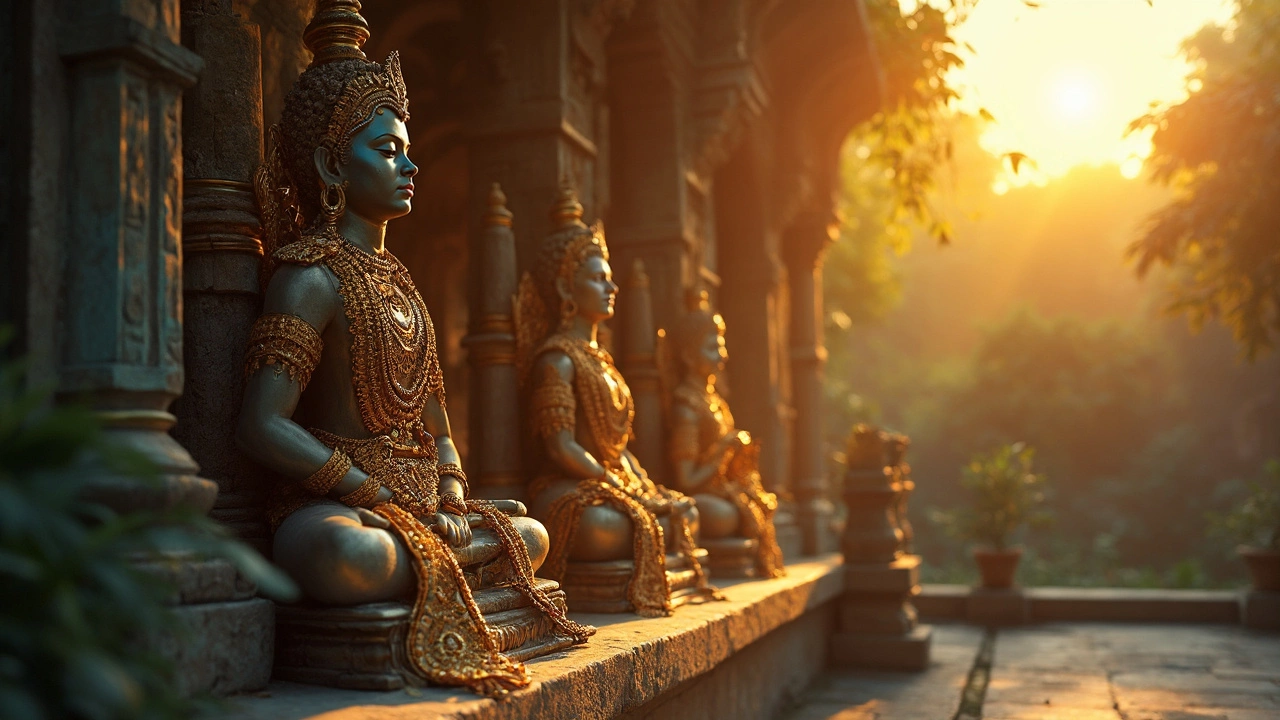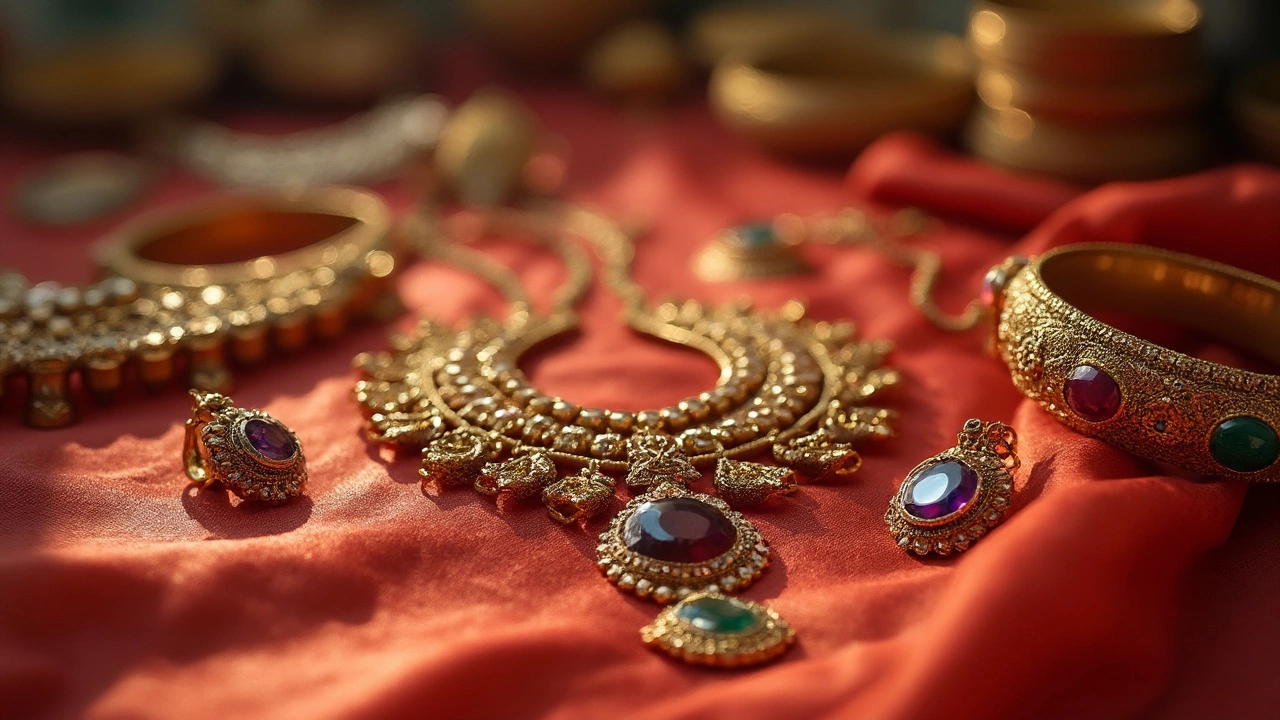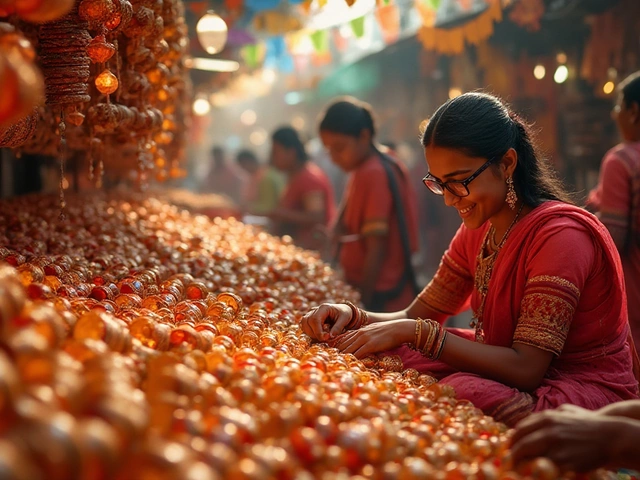
India has a rich and intricate jewelry tradition, and temple jewelry holds a special place in this glorious tapestry. But what exactly is temple jewelry? This type of adornment originally emerged in the 9th century, crafted for adorning the idols of the gods and goddesses in South Indian temples. Over time, the beauty of these pieces captured the hearts of everyone from royalty to the common folk.
Temple jewelry is typically made from gold, though it's not uncommon to find pieces embellished with precious gems like rubies, emeralds, and pearls. The designs often include motifs like peacocks, flowers, or traditional gods and goddesses, each intricately detailed by skilled artisans. Wearing these pieces isn't just about the bling—it's about embracing a slice of India's rich heritage. Imagine donning a piece of history every time you accessorize!
- History of Temple Jewelry
- Design and Craftsmanship
- Cultural Significance
- Modern Adaptations
- Tips for Buying Temple Jewelry
History of Temple Jewelry
Temple jewelry traces its roots back to the Chola dynasty, around the 9th century. It all began with the traditional ornaments crafted for temple deities, reflecting devotion through art. This wasn’t just bling for the divine; it symbolized spiritual wealth and artistic mastery.
Chola Dynasty Influence
The Chola empire, known for its patronage of the arts, fostered the creation of many intricate designs that still influence Indian jewelry today. These early designers were not just skilled in jewelry making, but also adept at capturing the spirit of the era in their creations. Goldsmiths, known as stapathis, created works of art that included carvings of deities, mythical creatures, and motifs expressing cultural myths.
Adorning the Gods
Initially, temple jewelry was strictly for the idols within the shrines. Priests would carefully adorn the statues with these pieces during festivals and rituals, adding an air of grandeur to the spiritual ceremonies. These momentous celebrations elevated temple jewelry to a sacred status, and the sheer opulence of the gold and gems spoke of devotion and reverence.
A Symbol of Royal Prestige
As time moved on, the aesthetic appeal of these pieces caught the eye of royals, transforming temple jewelry into status symbols. Kings and queens began to replicate these divine designs, wearing them as part of court attire, thus elevating temple jewelry from sacred symbols to cultural icons across South India. By setting trends among the elite, it gradually diffused through various strata of society.
Temple jewelry's historical journey from sacred temple thresholds to the wardrobes of the royal and eventually into mainstream fashion is a testament to its timeless allure. Today, it not only retains its cultural essence but also stands as a beloved artifact for both tradition enthusiasts and modern fashionistas. Whether it's a grand elaborate necklace or a subtle pair of earrings, these pieces are a rich page from history that's still being told today.
Design and Craftsmanship
Temple jewelry is a marvel of Indian jewelry craftsmanship. What sets it apart? Let's break it down to the nuts and bolts. Imagine intricate motifs brimming with religious and cultural symbolism, all etched in gold, and you get an idea of its complexity. Each piece is painstakingly handcrafted by skilled artisans who have often inherited their craft through generations.
The creative process begins with selecting the base material, usually pure gold, which is quite durable and malleable, making it perfect for intricate designs. Artisans then move on to carving elaborate patterns and motifs. You’ll often see images of gods and goddesses, animals like elephants and peacocks, and a splash of floral designs. It's not just about looks—these designs hold deep-rooted meanings, connecting the wearer with stories from Indian mythology.
Attention to Detail
Details matter immensely when it comes to temple jewelry. Every curve and line is designed meticulously. Many pieces are also adorned with beautiful stones like red rubies, green emeralds, and sometimes pearls. They're not just there for sparkle; each stone is carefully selected to complement the rest of the piece and enhance its overall theme.
Tools of the Trade
The artisans use tools that have been refined over centuries. Simple metal tools for carving are accompanied by modern implements that ensure precision. But technology hasn't replaced the age-old techniques. There's an indelible human touch that machines simply can't replicate.
| Aspect | Description |
|---|---|
| Technique | Handcrafted, ornate design with historical symbols |
| Materials | Primarily pure gold, adorned with precious stones |
| Common Motifs | Gods, goddesses, animals, floral designs |
When you're shopping for temple jewelry, you're not just buying an accessory. You're investing in a piece of heritage. Imagine wearing a piece that tells a story, connects you to a culture, and wow, doesn’t it sound amazing?

Cultural Significance
Temple jewelry isn’t just beautiful; it’s steeped in rich cultural history and significance. Originating from the southern parts of India, particularly Tamil Nadu and Karnataka, these pieces were initially crafted to adorn deities in the temples, symbolizing divinity and grace. This alone sets the tone for their importance—they were literally meant for gods!
The influence of temple jewelry extends beyond mere ornamentation. It plays a pivotal role in traditional dance forms like Bharatanatyam and Odissi. Dancers wear these pieces to enhance the emotive storytelling of their performances while paying homage to the art's divine origins. The intricate designs and traditional motifs not only embellish but also narrate ancient tales and legends.
The Royal Connection
Temple jewelry gradually became a symbol of wealth and stature. Royals and wealthy patrons commissioned these artisans to create bespoke pieces for their personal collections or as gifts for temples. The jewelry thus often features intricate craftsmanship and high-quality materials such as pure gold, polished to perfection.
A Link to Tradition
In many Indian households, temple jewelry is part of family heirlooms, passed down through generations, symbolizing longevity and tradition. Wearing these pieces during festivals or weddings represents purity and divine blessings—a significant ritual for ensuring prosperity and happiness in one's life journey.
Modern Cultural Impact
Today, temple jewelry still holds a profound cultural significance. Its intricate designs have inspired contemporary jewelry makers, keeping the tradition alive in both urban and rural domains. It’s not uncommon to find replicas in various metals, making them accessible to a broader audience while still celebrating their heritage. Temple jewelry thus continues to bridge the past and the present, ensuring the legacy of India’s opulent past is never forgotten.
Modern Adaptations
Today, temple jewelry isn’t just hanging out in museums or temple vaults. Nope, it’s strutting down fashion runways and jazzing up wedding outfits. Thanks to its timeless beauty, temple jewelry has evolved into a fashionable accessory that still pays homage to its rich origins.
Contemporary designers are putting a modern spin on these traditional treasures. They’re crafting them in sleek, wearable styles fit for a night out or an upscale event. For instance, pairing a classic temple-inspired pendant with a minimalist chain gives it a fresh, chic vibe.
Fusion Styles
Fusion styles are also big right now. Picture this: temple motifs meet Western designs, resulting in earrings and bracelets that look like they belong both in a traditional Indian setting and a New York nightclub. These pieces maintain intricate artistry but merge with simpler designs to appeal to a broader audience.
Cultural Symbolism
The popularity of temple jewelry in modern fashion isn’t just about aesthetics. It’s a way for many to connect with their cultural roots. Wearing these pieces is like wearing a story—a blend of myth, artistry, and heritage, making it a meaningful addition to any outfit.
Eco-friendly Initiatives
Interestingly, eco-friendly trends haven’t left temple jewelry untouched. Designers are now exploring sustainable materials like recycled metals or ethically sourced gems. This move caters to environmentally conscious folks who want their accessories to have as little impact on the earth as possible.
| Traditional Element | Modern Twist |
|---|---|
| Kasu Malai Necklace | Layered with Contemporary Chains |
| Temple Bangles | Used as Statement Pieces |
| Earring Designs | Combined with Studs |
So, next time you spot temple jewelry at a party or a friend's wedding, chances are it’s making a fashionable yet tasteful comeback. Why not try it for yourself?

Tips for Buying Temple Jewelry
Venturing into the world of temple jewelry can be an exciting journey. Whether you're a collector or just looking for a unique piece, a few tips can go a long way in ensuring you buy authentic and meaningful jewelry.
1. Understand the Craftsmanship
Temple jewelry is known for its intricate designs and attention to detail. Before making a purchase, take some time to learn about the different motifs and styles. Look for pieces that showcase the delicate workmanship often seen in traditional designs, featuring elements like god or goddess figures, lotus flowers, or peacock motifs.
2. Check Authenticity
Since temple jewelry is predominantly made from gold, verifying authenticity is crucial. Look for hallmarks or certification that specify the carat weight. Reputable sellers should provide this information upfront. Also, consider if embellishments like rubies or emeralds are real or synthetic.
3. Know Your Seller
Buying from a trusted seller is half the battle won. Seek recommendations or read reviews about the seller's reputation. In India, cities like Chennai or Bangalore are known for their authentic sellers who specialize in this type of jewelry. Some jewelers have been crafting these pieces for generations.
4. Consider the Occasion
Temple jewelry is traditionally worn for special occasions like weddings or religious ceremonies. When shopping, think about when and where you'll wear it. If it's for a specific event, choosing something that complements your outfit and the occasion is key.
5. Budget Wisely
Temple jewelry can be a significant investment, so it's important to set a budget beforehand. Keep in mind that intricate designs generally cost more due to the skill involved. Don’t hesitate to compare prices from different sellers to ensure you're getting the best deal.
| Attribute | Details |
|---|---|
| Material | Mainly Gold, with precious gemstones |
| Popular Cities | Chennai, Bangalore |
Remember, buying Indian jewelry is not just a financial purchase but also an emotional one, as each piece carries centuries of history and culture. With these tips in hand, you're ready to explore the stunning world of temple jewelry with confidence!


